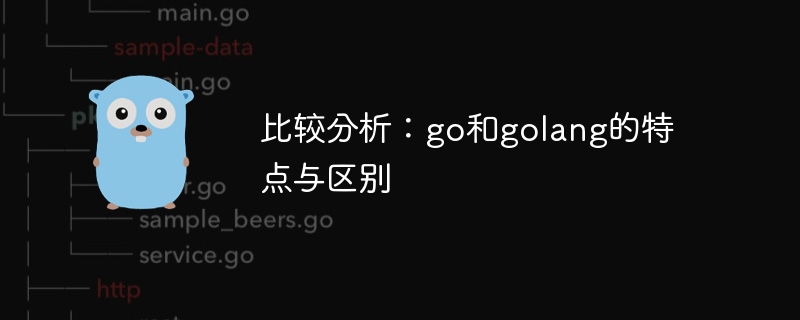

Title: Comparative Analysis: Characteristics and Differences between Go and Golang
Introduction:
In the field of modern programming, Go (also known as Golang) is a A high-profile programming language known for its simplicity, efficiency, and concurrency. Go is an open source programming language released by Google in 2007. As a statically typed, compiled language, it has attracted the attention and love of many developers. However, for some historical reasons, Go is sometimes called Golang. This article will comparatively analyze the characteristics and differences between Go and Golang, and provide code examples to illustrate the differences.
1. The name and origin of the language:
The official name of Go is "Go", which was developed by Google and first released in 2009. The term "Golang" is a term coined by the developer community to distinguish other programming languages with similar names. Although both terms can be used to refer to the language, "Go" is more common and widely used.
2. Language design concepts and goals:
The design concepts and goals of Go and Golang are very similar, with the main goals of improving development efficiency and code simplicity. They all focus on readability, ease of maintenance, and high performance, and adopt a syntax style similar to C language. Go/Golang provides a rich and powerful standard library, combining the characteristics of static typing and compilation.
3. Code examples - Concurrency:
Go/Golang is famous for its concurrent programming capabilities. Through the two key concepts of goroutine and channel, it achieves easy and efficient concurrent programming.
The following is a sample code that uses goroutine and channel to implement simple concurrent calculations:
package main
import "fmt"
func calculateSum(numbers []int, resultChan chan int) {
sum := 0
for _, num := range numbers {
sum += num
}
resultChan <- sum
}
func main() {
numbers := []int{1, 2, 3, 4, 5}
resultChan := make(chan int)
go calculateSum(numbers[:len(numbers)/2], resultChan)
go calculateSum(numbers[len(numbers)/2:], resultChan)
partialSum1 := <-resultChan
partialSum2 := <-resultChan
totalSum := partialSum1 + partialSum2
fmt.Println("Total sum:", totalSum)
}In the above code, we define a calculateSum function to calculate the sum of a set of integers. Use goroutine and channel to implement concurrent calculations, divide the calculation task into two parts, calculate them separately by the two goroutines, and pass the results to the main goroutine through the channel. Finally the two partial sums are added together to get the final total.
4. Features and differences:
Although Go and Golang are essentially the same programming language, there are some subtle differences:
Summary:
Go and Golang are essentially the same programming language, and both have the characteristics of efficiency, simplicity and concurrency. Although there are some subtle differences, in practice they do not have a significant impact on the development experience and results. No matter what you call this language, learning and mastering it can bring great convenience to your software development.
The above is the detailed content of Comparative analysis of the characteristics and differences between Go language and Golang. For more information, please follow other related articles on the PHP Chinese website!
 Usage of Type keyword in Go
Usage of Type keyword in Go
 How to implement linked list in go
How to implement linked list in go
 What are the Go language programming software?
What are the Go language programming software?
 How to learn go language from 0 basics
How to learn go language from 0 basics
 How to define variables in golang
How to define variables in golang
 What are the methods to implement operator overloading in Go language?
What are the methods to implement operator overloading in Go language?
 What are the operators in Go language?
What are the operators in Go language?
 What are the data conversion methods in golang?
What are the data conversion methods in golang?




